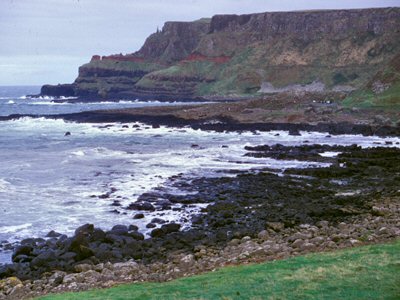Earth Science Conservation Review
| Giant's Causeway - Mineralogy | Antrim |
| Site Type: | Cliff, Coastal section, Inactive scree |
| Site Status: | ASSI |
| Council area: | Moyle District Council |
| Grid Reference: | C947448 |
| Google maps: | 55.24155,-6.51118 |
| Rocks | |
|---|---|
| Rock Age: | Tertiary (Eocene, Palaeocene) |
| Rock Name: | Antrim Lava Group |
| Rock Type: | Basalt, Tholeiite |
| Interest | |
| Minerals: | Analcime, Chabazite, Chalcedony, Natrolite, Opal, Phillipsite, Quartz, Stilbite, Thomsonite, Zeolites, Heulandite, Mesolite, Scolecite, Chlorophaeite, Celadonite, Paulingite |
| Other interest: | vesicles |
Summary of site:
The zeolites are a group of minerals normally associated with igneous rocks, particularly lavas, where they tend to fill or line cavities formed by bubbles of volatiles trapped in the final stages of cooling and solidification. They are thought to result from the circulation of hot, mineral-charged waters associated with the vulcanicity.
The Giant's Causeway is noted for the variety of zeolites found in its flows of columnar basalts and nine have been identified so far. Cavities at the Causeway also contain other minerals, such as micas and a range of quartzes (of which opal is noteworthy).
A tenth and rare zeolite, paulingite, has been found in cavities in the loose boulders lying in Portnaboe, below the road descending to the causeways. Presumably they were detached from the cliffs of Weir's Snout behind and above.
Most zeolites are collected from boulders in scree which are intrinsically unstable and should therefore be avoided. In any case the National Trust, the site owner, forbids all collecting within the World Heritage Site.
The Giant's Causeway is noted for the variety of zeolites found in its flows of columnar basalts and nine have been identified so far. Cavities at the Causeway also contain other minerals, such as micas and a range of quartzes (of which opal is noteworthy).
A tenth and rare zeolite, paulingite, has been found in cavities in the loose boulders lying in Portnaboe, below the road descending to the causeways. Presumably they were detached from the cliffs of Weir's Snout behind and above.
Most zeolites are collected from boulders in scree which are intrinsically unstable and should therefore be avoided. In any case the National Trust, the site owner, forbids all collecting within the World Heritage Site.
| Enlander, I., Dempster, M. & Doughty, P., 2025. Giant's Causeway - Mineralogy, County Antrim, site summary. [In] Earth Science Conservation Review. https://www.habitas.org.uk/escr/summary.php?item=533. Accessed on 2025-04-03 |
| Previous Site | Next Site |


